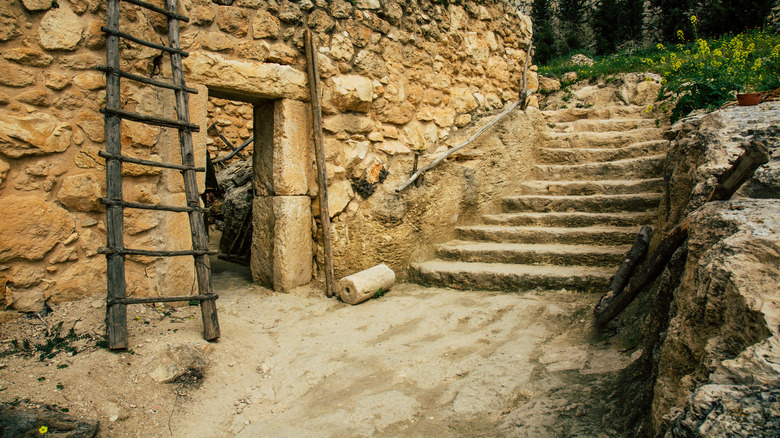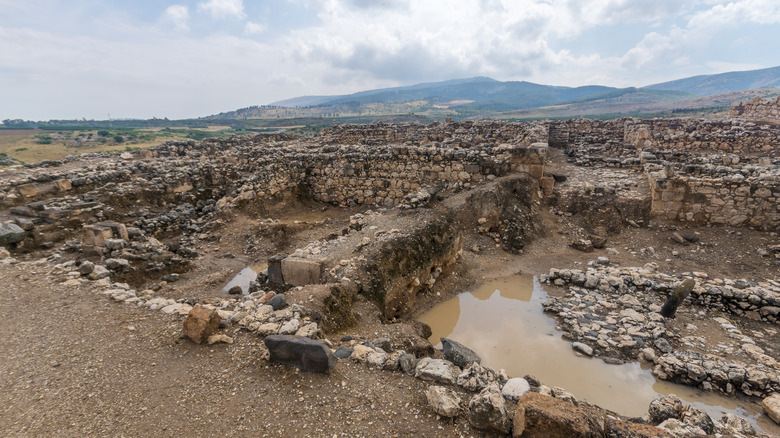Parts Of The Bible That Science Has Confirmed To Be True
Serving as both a history book and a life manual of sorts for nearly a third of the global population, the Bible is one of the most frequently read and widely distributed books in the entire world. In a 2014 YouGov survey conducted among more than 2,000 British adults, the Bible was named the world's most influential book. This is hardly surprising, since hundreds of millions of Bibles change hands every year.
That said, it's inevitable for doubts to arise about the accuracy and authenticity of a book with over 30 authors (and whose oldest chapters are at least 2,700 years old). Given how some believers take everything written in the Bible as absolute truth, a number of skeptics have questioned just how credible its words are, particularly with regard to scientific accuracy.
The Bible was written before modern science could shed light on how species extinctions affect nature or why it's important to wash our hands properly — which is why it's fascinating to note how certain interpretations of Biblical text end up aligning with today's scientific knowledge. Obviously, searching for 100% literal scientific accuracy in the Bible is a fool's errand, for many reasons. Still, the following examples of spiritually syncing nicely with science do merit a closer look.
Humans are related 'by blood' (and cannot live without blood)
Two chapters of Genesis tell the story of Adam and Eve, a specific take on the origin of humanity that's so well-known, pretty much everyone's familiar with it (or some version of it). And while it's understandably challenging to imagine a person being formed out of another person's rib, science says it's likely that all of Homo sapiens really did have a common ancestor — a "Mitochondrial Eve."
Homo sapiens likely originated in Africa approximately 300,000 years ago, a period of time during which the world's climate was undergoing some drastic changes. The shared maternal ancestor of all modern humans may have been a female who lived at some point between 200,000 and 170,000 years ago. This is supported by the fact that Africa has more genetic diversity than all other regions of Earth combined.
Meanwhile, Leviticus 17:11 talks about how the life of a creature is in its blood. Interestingly enough, one can consider a literal interpretation of this to be scientifically accurate. Apart from traveling around the body to supply oxygen, nutrients, and other vital elements for continued survival, blood also protects the body via infection-fighting agents, prevents blood loss through clotting, regulates body temperature, and even ensures that waste products go to the liver and kidneys like they're supposed to.
Earth's water is always changing states
In a paper published by the University of Burgundy, hydrologist James Dooge shares some facts that show the roots of our understanding of Earth's water cycle. According to Dooge, ancient ideas about water's relationship with the planet can be traced back as early as 1,000 B.C., with the Greek poet Homer depicting Earth "floating on a primal ocean." Of course, humanity's understanding of the water cycle has greatly improved since then. Nowadays, scientists understand that Earth's water cycle (or hydrologic cycle) involves water's never-ending movement and state changes across, above, and even within the planet.
However, the distinction of being the hydrologic cycle theory's "discoverer" typically goes to Bernard Palissy, a hydraulics engineer who, in 1580, published that maintaining rivers was possible with just rain. His theories would be tested nearly a hundred years later, and only gained traction among scientific thinkers in the early 1900s.
Interestingly enough, interpreting a few passages from the Bible in a certain way shows alignment with how modern science understands evaporation, condensation, and precipitation. Ecclesiastes 1:7, for instance, describes how water flowing from streams into the sea eventually returns to its origin. Meanwhile, both Amos 9:6 and Job 36: 27-28 reference water rising from larger bodies of water, such as seas or streams, and then falling back to Earth as rain. Even Psalm 135:7 talks about clouds rising and then pouring down as rain.
Earth is not flat, is hot inside, and is not propped up by anything
As the Bible probably wasn't written with scientific accuracy in mind, determining how its text could get along with science requires an openness toward interpretations that aren't literal. For example, Isaiah 40:22 talks about "the circle of the earth," which some interpret as a reference to Earth being circular when seen from outer space (via Baguio Herald Express). There's photographic proof of this, of course: The famous photo "Earthrise," which was snapped on December 24, 1968, by Apollo 8's crew, shows Earth as an orb floating in space. (The idea that Earth isn't flat isn't a new one, though — thinkers like Pythagoras and Eratosthenes were already toying with the idea well before Jesus Christ was born.)
There are more lines in the Bible that seemingly match scientific truths about the Earth. Take Job 28:5, for instance, which talks about how hot the Earth is deep inside, and temperatures inside the Earth can rival the degree of heat on the Sun's surface. Another noteworthy example is found in Job 26:7: Here, the chapter's writer talks about how the Earth is simply floating in space, unsupported by any fixed physical structure whatsoever.
There are many, many stars, each with different degrees of brightness
Judging from what today's scientists know about the stars, Jeremiah 33:22 had the right idea by saying that the stars in the sky were "countless." There could be up to a trillion stars in a single galaxy, although that's just a rough estimate, based on the evidence that astronomers, astrophysicists, and other space scientists have to work with. Applying some good old math to this makes the picture even clearer: Across the universe's 100 billion galaxies, there could be approximately 10^22 (ten billion trillion, or a 1 followed by 21 zeros) stars.
Meanwhile, a literal interpretation of 1 Corinthians 15:41 would reveal an astonishing level of alignment with modern astronomy, at least in terms of stars' brightness or magnitude. The Bible verse talks about the different "splendors" of the Sun, the Moon, and other stars in the universe. As it turns out, there's a clear scientific reason why certain stars look brighter to Earthlings than others: Stars vary in brightness from the vantage point of people on Earth, and this depends on factors such as the amount of light energy a star emits, how far it is from the planet, and more.
Heavenly bodies don't last forever
The Bible includes constant reminders about how things will end. The Book of Revelation paints a particularly grim picture of how this will go down, but it's hardly the only part of the Scriptures that talks about the finiteness of everything. In fact, the Bible even discusses how the stars in the sky and other celestial bodies won't last forever, centuries before modern science could support this with evidence.
According to Matthew 24:35, both heaven and Earth will eventually "pass away." In the context of astronomy, stars reach the end of their lives once they've exhausted all the nuclear fuel that keeps them burning. The bigger the star, the faster it burns through its hydrogen fuel. And when the fuel's completely depleted, the star either collapses by a finite amount to become a white dwarf or a neutron star (if it's not that massive), or goes all the way to an infinitely dense singularity and becomes a black hole (if it's massive enough).
A black hole has an incredibly strong gravitational field due to the star's mass; it's so strong that not even light can escape it. For a long time, however, the existence of black holes (as proposed by Einstein in the early 20th century) couldn't be proven with direct evidence. In fact, the first-ever photograph of a black hole was taken on April 10, 2019 — a historic endeavor that required 200 scientists and eight super-powerful telescopes across five continents.
The universe is made up of invisible components
According to Hebrews 11:3, God didn't make the universe "out of what was visible." One way to interpret this is that the building blocks of the universe are simply imperceptible to the naked human eye — and of course, physics supports that notion with the concept of extremely tiny atoms making up virtually everything.
Atoms are what form pretty much all that the human senses can perceive, from everyday objects to other people to the planet itself. Identical atoms, when together, form the chemical elements, which are the simplest forms of substances obtainable through ordinary chemical processes.
Atoms are so small that if you were to take 100 million hydrogen atoms and line them up, they would not exceed a centimeter in length. Atoms are made up of even smaller particles: It would take a thousand protons or neutrons to match the diameter of a single hydrogen atom. Protons and neutrons, in turn, are a thousand times bigger than electrons. Does your head hurt yet?
A great flood likely did happen (and Noah's Ark could have actually floated)
Yet another well-known story from the Bible is the tale of a world-engulfing flood and Noah's ark (also known as the Noachian Flood). This story is spread out throughout three chapters of Genesis, detailing how one man and his family successfully constructed an ark and saved all the planet's animals from a massive flood that lasted 40 days.
The geological record certainly supports floods occurring throughout Earth's history. However, it is highly unlikely that water engulfed the Earth's entirety in a single flood, as the Noachian Flood story describes. This is due to the fact that it's not possible for evaporite deposits to have formed simultaneously, going by fossil evidence and basic scientific knowledge. It's probable that the "Great Flood" was just a regional flooding event that looked like a world-ending flood to anyone affected by it.
And then there's the ark. At first glance, it may seem impossible for such a vessel to properly accommodate 35,000 different animal species and float. However, some people have crunched the numbers and learned that such an ark could indeed float. (Whether all the animals could actually fit in there, however, is an entirely different topic for discussion.)
What Nazareth was like in Jesus' time
The Bible paints a particular picture of Nazareth, the city in Israel where Jesus Christ reportedly lived. According to the site, the biblical Nazareth was "a community that followed Jewish religion and customs," and wasn't particularly fond of the Romans. Archaeological digs in recent years support this idea — and may have even revealed the house where Jesus spent his early years.
In an interview with LiveScience, Ken Dark, a professor at the United Kingdom's University of Reading, talked about the discovery of a first-century house that, for some reason, served as the foundation for a place of worship called the Church of the Nutrition. The house was also decorated with mosaics. Most interestingly, 12th-century Crusaders reportedly worked on restoring the church after it had experienced dilapidation, perhaps due to poor maintenance. As it turned out, they also believed that the house formerly belonged to Jesus.
Meanwhile, other excavations reveal strong evidence that people living in Jesus-era Nazareth were completely opposed to the Romans and their culture. Based on findings from a survey of the Nahal Zippori valley, archaeologists found that the people living in the southern side — the area closer to Nazareth — had an equal amount of disdain for the Romans.
David really could have won against Goliath that easily
The way it was told in 1 Samuel 17, it might be difficult to picture how David, a small boy with a slingshot, took out the battle-hardened brute Goliath. However, if this theory about Goliath were true, then David winning was a highly likely outcome, if not a foregone conclusion.
Many mistakenly think that David was just carrying a child's toy. While a slingshot may not sound as impressive as, say, a sword or a pike, it could be an absolute killer in the right hands and with the right ammunition. And David was working with arguably the best bullets available: the stones from Elah Valley were made of barium sulfate, and so were twice as dense as the average stone. In other words, David's slingshot was a 35-meter-per-second death dealer, hitting his gigantic foe with the awesome power of a .45 caliber pistol.
That's just half of it, though. Goliath may have looked imposing, but the way he was described in the chapter suggests that his gigantic frame may have come at a terrible cost to his health. If Goliath was as giant as the Bible describes — and was real –he may have suffered from acromegaly, an overproduction of growth hormones caused by a tumor in the pituitary gland. This also means that Goliath likely had poor eyesight: Acromegaly can cause a person to lose their peripheral vision, limiting what they can see to what's in front of them.
The Sun really did stop moving — because an eclipse happened
Joshua 10:12 attributes a key biblical victory to the fact that God supposedly made the Sun "stand still." Two men of physics saw this as an opportunity to shed light on what could have been a remarkable astronomical phenomenon — and the only tools at their disposal were words and math.
In their 2017 paper "Solar eclipse of 1207 BC helps to date pharaohs," Sir Colin Humphreys and Graeme Waddington discuss how this game-changing event could have actually been a solar eclipse. They started by speaking to a Semitic languages professor to determine if the account, originally written in Hebrew, could have actually been talking about an eclipse. After learning that it was a possible annular eclipse (an eclipse in which the Moon doesn't cover the Sun entirely), they cross-referenced it to another source, the ancient Egyptian-made Merneptah Stele, to strengthen their hypothesis.
Not content with what they'd unearthed, they even went so far as to calculate for the exact date it happened. By performing some fancy arithmetic (and factoring in the fact that the world spun a bit faster than it does today), the researchers were able to pinpoint a date that lined up with the biblical timeframe: October 30, 1207 B.C.
The proper way to handle skin diseases, dead bodies, and human waste
When you hear about the Bible, health and safety guidelines probably aren't the first things you'll think of. But, interestingly enough, the book has quite a few of them.
Leviticus 13:1-5 brings up the idea of isolating a patient suffering from a "defiling skin disease" for seven days and observing if their skin condition improves. This is evidence of quarantine before quarantine was even officially a thing: The practice of holding or isolating infected patients for 40 days actually started in A.D. 1377, when the city now called Dubrovnik, Croatia, forced ships from areas affected by the Black Death to undergo a 30-day isolation period. This eventually increased to 40 days, for reasons that scholars aren't completely sure about, but one theory is that the number 40 may have been inspired by the number's significance in the Bible.
Meanwhile, Leviticus 11:28 and Deuteronomy 23:13 emphasize the importance of cleaning oneself after handling corpses and the proper disposal of decomposing matter, respectively. It may come as a surprise that even though such guidelines are now common sense, this wasn't always the case. Take the story of Ignaz Semmelweis, the father of handwashing: His investigation of a mid-19th century outbreak of childbed fever in Europe revealed that doctors of the time didn't wash their hands properly when they went from handling cadavers to assisting women in childbirth.
How mountains form above the ground and under the ocean
Numerous creation myths from various cultures assert that the mountains of Earth were manually crafted by deities. That's why it's a bit of an oddity that the story of Creation in the book of Genesis doesn't directly mention God shaping the mountains by hand. As it turns out, this small omission could be interpreted as having some chance scientific accuracy.
Science has an explanation for how mountains are formed: When the tectonic plates on Earth's crust collide, their edges may crumple, forming the gigantic layers of rock and sediment that become mountains. At least two passages from the book of Psalms (104:6 and 104:8) talk about mountains underwater. If these texts are interpreted literally, they may actually be referring to seamounts, which are actually mountains formed from powerful volcanic activity underneath the ocean. Just like terrestrial mountains, seamounts become rich grounds for biodiversity to flourish, due to the fact that they help bring nutrients from the seafloor to the flora and fauna that live near the water's edge.
Egypt had a Semitic population before Exodus
Genesis 37 tells the story of Jacob, the Hebrew patriarch whose brothers sold him into enslavement in Egypt. The Israelites later followed Jacob into Egypt, as told in Genesis 46, due to famine. While the story may not have unfolded exactly as told, there is concrete evidence for its historical context, given the presence of fellow Semitic speakers in Middle and New Kingdom Egypt. For starters, the worship of the God of Israel, YHWH, is attested in Egypt at the correct time. The Soleb Lists of Amenhotep III (dated to around the 15th century B.C.) list a people called the Shasu, a catch-all term the Egyptians used for the desert nomads of the Sinai. Among them are the Shasu of "yhw," which scholars generally interpret as a rendering of the Tetragrammaton – the four Hebrew letters that make up God's name, expanded as Yahweh.
Some of these Semitic nomads even governed Egypt at one point. Egyptian annals speak of the Hyksos, who were not a single group, but an amalgam of Semitic tribes, who immigrated to Egypt during the Middle Kingdom. Eventually some of them managed to take over the northern part of the country and install themselves as pharaohs. These rulers all bore Semitic names, including one named Yaqub-har – a name resembling that of the biblical Patriarch Jacob (though not necessarily the same person). It is possible some of them were enslaved following the Theban conquest of Lower Egypt, providing the basis for the story of the Hebrews enslavement, but that is speculation.
A people called Israel clashed with Egypt in the Late Bronze Age
The Book of Exodus describes how Israelites and Egyptians butted heads, ascribed by biblical scholars as taking place sometime between 1400 B.C. and to the time of Ramses II or Merneptah in the late 13th century B.C. This is the only scientifically provable part of the story, as all similarities end in the Egyptian account of the conflict.
The first-ever mention of Israel by name occurs in a single line of Pharaoh Merneptah's Victory Stele, wherein Merneptah names the foreign lands he defeated. "Canaan has been plundered onto every sort of woe, Ashkelon has been overcome, Gezer has been captured, Yano'am is made non-existent, Israel is laid waste, his seed is no more" (via Professor Dermot Nestor's article "Merneptah's 'Israel' and the Absence of Origins in Biblical Scholarship"). From this, the only things that can be said with certainty about Israel are the following: Israel was located in the Levant, and was once defeated by Egypt. Although Merneptah grouped it with foreign lands, Israel is labeled in hieroglyphics as a people. This supports the biblical narrative of Israel as a wandering people rather than a political entity, which came later.
The interpretation is not without its critics, with some saying it must have been a scribal mistake. This lacks wider support, however, so it is likely that the scribe intended to write Israel. But without any further evidence, all that can be said is that a people called Israel most likely existed in the Late Bronze Age.
The Philistines came from Europe and the Aegean islands
Jeremiah 47.4 says Israel's Philistine enemies were not Levantine natives but "the remnant of the coasts of Caphtor." Biblical scholars generally equate this region with the Greek island of Crete, although alternative proposals have suggested Cilicia in Turkey in Phoenicia. If Caphtor is indeed Crete, however, then recent genetic evidence has shown that Jeremiah got it broadly correct here.
Near Eastern studies equate the Philistines with the people whom the Egyptians called the Peleset. They were one of the "Sea Peoples" who terrorized the Ancient Near East – pirates and migrants from places such as Greece and the Aegean, Anatolia, and even the Central and Western Mediterranean. Scholars postulate that conditions in these areas, including the collapse of the Mycenaean palaces of Homeric Greek fame, drove them East to seek greener pastures in the Levant. In 2013, scientists got a chance to test this theory when Israeli archaeologists discovered a Philistine cemetery near the city of Ashkelon.
The tests confirmed tradition. The study published in Science Advances found that the individuals tested were a bit of an anomaly. Bodies from the Late Bronze Age belonged to local Levantines – no surprises there. However, while remains from the more recent Iron Age also were mostly Levantine, they also carried genetic markers from Sardinia, Greece, and the Iberian Peninsula. The researchers concluded that some of the Philistines' ancestors migrated to the Levant in the Late Bronze Age, and intermarried with Levantines in an ethnogenesis that created the Philistines.
The cult of the golden calf near Mt. Sinai
Exodus 3:1-7 narrates that almost immediately after being delivered from Egyptian enslavement, the Israelites entered the Sinai Peninsula. While Moses was on Mt. Sinai, they turned on God by fashioning an idol in the form of a golden calf and worshipping it, in violation of the First Commandment. That golden calf was likely a reference to a deity we know was worshiped in the Sinai during the Late Bronze Age.
The sites of Serabit Khadim and Timna in the Sinai desert supplied Egypt with mining products, including copper and gemstones such as turquoise. Egyptians and local Canaanites worked in the mines, under the protection of the goddess Hathor, whom they referred to as the"Lady of Turquoise." This goddess, associated with sex and fertility, was worshiped not only at a temple in Serabit Khadim, but also in caves, and most pertinently, on mountains. In a tie-in to Exodus, the goddess was almost always depicted either as a woman with cow's ears and horns flanking the sun disk, or as a cow.
Exodus 32:6 says the Israelites' worship of the Golden Calf involved eating, drinking, and merriment. Archaeological evidence gives credence to this part in relation to Hathor, too, as the goddess' religious rituals often involved music and sexual activity among the participants.
King David existed
Warrior hero, prophet, ruler, adulterer – in the Bible, the Israelite King David stands as a larger-than-life figure, helping his people fend off a Philistine invasion in the Book of Samuel by killing the giant Goliath, and capturing Jerusalem from the Canaanites to establish the Israelite presence in what would become the Jewish holy city. Incredibly, however, despite his importance to the region's history and the Abrahamic world, scholars could find no extra-biblical traces of him, leading to doubts he had ever existed.
Since 1993, physical evidence for the existence of King David has surfaced. An Aramaic stela discovered at Tell Dan in Syria recounts that the author – believed to be King Haza'el of Damascus – defeated a handful of his enemies, including the Kingdom of Israel. "I slew [seve]nty kings], who harnessed thousands of Cha-]riots and thousands of horsemen (or: horses). [I killed Jeho]ram son of [Ahab] king of Israel, and [I] killed [Ahaz]iahu son of [Jehoram kin-]g of the House of David." (translation by Avraham Biran and Joseph Nave, published in the Israel Exploration Journal).
Although the stela is fragmentary and both its date and translation are debated, the reference to the "House of David" is fully visible, suggesting that the writer of the stela seemed to believe King David was a real person and scion of the dynasty of Israelite kings as named in the Bible.
The Pool of Siloam
In John 9, Jesus performs one of his best-known miracles when, near the Second Temple, he encounters a man who had been blind from birth. After a debate with a handful of other rabbis, Jesus puts clay and spit in the man's eyes and tells the him to go wash it off in the Pool of Siloam, after which he miraculously is able to see. While science has nothing to add about such a miracle, it has found exactly where it would have occurred.
Christian tradition held that the Pool of Siloam was located near a church built by the Byzantine Empress Eudokia to commemorate the spot, but the actual location of the first-century-era pool was lost to the ages. But in 2004, a pair of Israeli archaeologists found it elsewhere, near the Temple Mount.
Measuring at over 200 feet, the pool, which was fed by a network of underground springs, was strategically positioned for Jewish pilgrims attempting to access the Temple Mount. Pilgrims had to be ritually purified, while those with disabilities were banned from the Temple Mount. Thus, the Pool of Siloam, placed along the road to the Second Temple, provided the perfect place to bathe.
Jezebel was a pagan
In 2008, Professor Marjo Korpel claimed to have confirmed that an ancient seal truly belonged to the Phoenician Queen Jezebel. As the much-maligned wife of the Israelite King Ahab, Jezebel is excoriated in the Bible for persecuting God's prophets and attempting to replace him with her native Phoenician gods. Kings 21:8 notes that she used seals such as the one Korbel analyzed, and if that seal is in fact hers, it would confirm that she was very much committed to her native religion.
The seal bears four Phoenician-style Aramaic letters that together read "yzbl." Careful examination by Korbel determined, she claims, that there is also a missing "l," which would spell "of/belonging to Jezebel." It is decorated with a handful of Phoenicianized Egyptian symbols, including a winged sphinx, the ankh (symbolizing life), serpents, and a falcon – a symbol of both the sun and royalty in Egyptian mythos. Korbel argues that these symbols were historically associated with royalty who claimed divine or semi-divine status — hardly the kind of iconography that a Hebrew would use for her personal seal.
In Phoenicia, the queen was considered the wife of the supreme god Baal — one of the Israelites' most hated adversaries. Jezebel's own name means "Where is his Highness (Baal)," a likely reference to Phoenician mythology and its idea that the queen made or broke her husband's rule – hence the symbols of life and kingship on the seal.
Pontius Pilate definitely existed
Little is known about Pontius Pilate, the man who oversaw Jesus' crucifixion. Ironically, he is the best-attested governor of the province he oversaw, yet all that is known about him are the few details from the Bible and his cruelty, as described by ancient writers like Josephus, Philo of Alexandria, and Tacitus. To top it all off, there was no material evidence whatsoever that he was real until 1961, when an Italian excavation discovered a dedicated marble slab in the Roman city of Caesarea Maritima, confirming that he really lived in Judea during Jesus' time.
The marble slab, known as the Pilate Stone, provides precious little information, but it does fit the early imperial context and chronology of the Gospels. It says that Pilate reigned under the Emperor Tiberius, to whom the inscription is dedicated. So, if Pilate were a contemporary of Tiberius, he would also have been a contemporary of Jesus Christ and, more significantly in this case, John the Baptist.
The latter began his ministry in Tiberius' 15th year, according to Luke 3:1. Tiberius reigned from A.D. 14-37, meaning John the Baptist began preaching Jesus' coming around A.D. 29. There is little else to glean from the stone, which is too heavily damaged, but at least it confirms Pilate was real.
Some of the cities Joshua destroyed really were destroyed
The Book of Joshua recounts the campaigns of Moses' eponymous successor in the Promised Land. According to the Old Testament, among Joshua's achievements was the destruction of a handful of cities such as Hazor, Gezer, Lachish, and most famously, Jericho. While there is no scientific, archeological evidence that anyone called Joshua destroyed the cities, they did exist, and at least two were destroyed when the Israelites were militarily active in the Late Bronze Age/Early Iron Age.
Those two cities are Lachish and Hazor, and they were incontrovertibly destroyed. Israeli archaeologist David Ussishkin noted in his book "Biblical Lachish" that the city burned in a massive conflagration around 1130 B.C. and was abandoned for two centuries. Ussishkin notes that the archaeology mostly squares with the biblical narrative, in that the city had no large fortifications, and thus was ruthlessly captured in short manner (two days, according to Joshua 10:31-33).
Joshua 11:10 also briefly mentions the destruction of Hazor. Israeli archaeologist Yigael Yadin excavated the city and found it was also destroyed in the Late Bronze Age – he believed around 1230 B.C. Only four groups are likely to have destroyed the city during that period: Egyptians, rival Canaanites, Philistines, or Israelites. Egyptian and Canaanite statues – particularly those of gods and rulers – were smashed, making it unlikely either of the former two were responsible. The early Philistines — who have been associated with the infamous Sea People — operated on the coast, whereas Hazor was an inland settlement. This leaves only the Israelites. Considering the First Commandment's prohibitions on idolatry, they are the likely culprits, although scholars are still debating whether the period of destruction lines up with the emergence of the Israelites as a military force.
Genesis' watery pre-creation world
Genesis 1:2, the hotly-debated creation narrative, says that in the very beginning, "earth was without form or shape, with darkness over the abyss and a mighty wind sweeping over the waters." This is by no means unique to Genesis – Egyptian mythology said the world came out of primordial waters of chaos. Although Genesis is scant on specific details of pre-Creation Earth, one scientific study suggests that the Bible's description of a watery world matches the hard evidence.
The study, published in Nature Geoscience, found that over 3 billion years ago, the concentration of oxygen-18 was much greater in the ocean of the Archaeozoic Eon than in later times. The Archaeozoic ocean was much bigger than today's — up to 1.7 times — but they found that over time, the oxygen concentration increased in sediments while decreasing in the ocean. These earlier higher concentrations could have been due to the lack of continents or other large landmasses, which had yet to form through tectonic activity.
It should be noted, however, that the two descriptions do not match 100%. The study authors noted that there probably were very small landmasses, with one, Boswell Wing, telling Tech Times, "I imagine a picture kind of like what it must look like to approach the Galápagos Islands from the west: vast expanses of ocean waters to the north and south with small volcanic rocky islets barely poking above the ocean surface."
Seismic activity did occur around the time of the Crucifixion
After Jesus' crucifixion, Matthew 27:51-52 states: "The earth quaked, rocks were split, tombs were opened, and the bodies of many saints who had fallen asleep were raised." That earthquake, however, is tricky to confirm scientifically. Early Christian tradition mentions an earthquake in Anatolia, noting that the Emperor Tiberius exempted a handful of damaged or destroyed cities from taxation, but nothing in Judea.
Despite the lack of textual evidence, geologists have identified seismic activity as having occurred around the time of the Crucifixion. A 2012 study published in the International Geology Review found that a 6.3 magnitude earthquake hit Judea sometime during the time of Christ. However, dating earthquakes usually comes with a five-year margin of error in either direction. Thus, all that can be said for certain is that an earthquake occurred between A.D. 26 and A.D. 36, coinciding with the governorship of Pontius Pilate.
The authors noted that the earthquake would have been strong enough to cause some damage, but not so much that it would have made it into the historical record, which could explain why virtually no one save for the Gospel of Matthew reported it.























